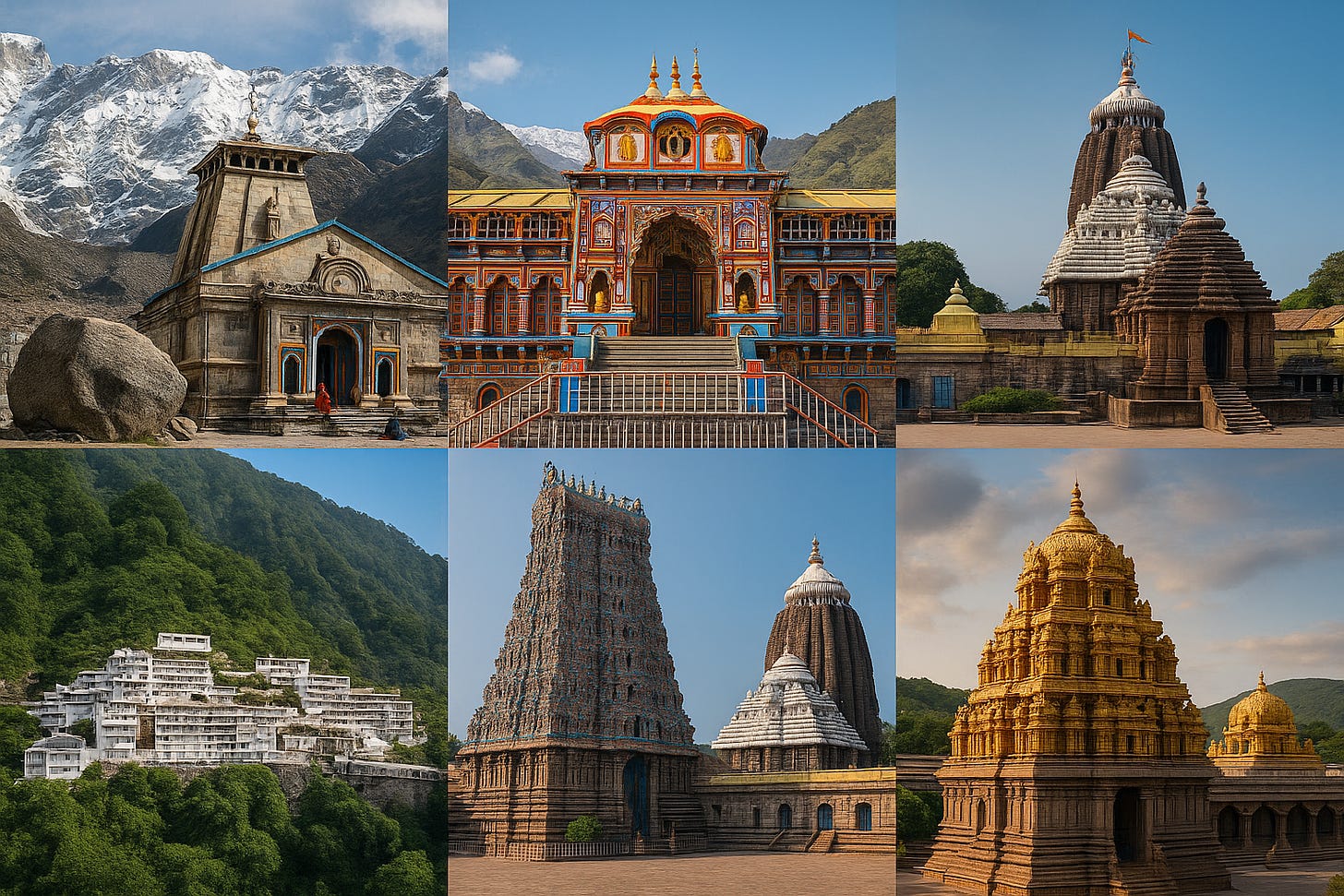Guardians of Faith: The Enduring Sanctuaries of India Believed to be Divinely Protected
India’s sacred geography is an intricate tapestry of legends, rituals, and living faith. Among its countless shrines, some temples are held in exceptional reverence - not just for their sanctity but for the deep-seated belief that the presiding deity acts as a divine guardian, shielding the temple and its devotees from misfortune. These are temples where faith intersects with history, miracles, and unexplained phenomena, inspiring awe across centuries.
1. Kedarnath Temple, Uttarakhand: The Unbroken Abode of Shiva
History & Architecture:
Believed to have been built by the Pandavas and revived by Adi Shankaracharya in the 8th century CE.
Constructed from massive grey stone slabs in a simplistic yet powerful Nagara style, resilient against extreme Himalayan weather.
Rituals & Worship:
Priests (belonging to the Veerashaiva community of Karnataka) perform daily rituals, including abhishek of the Shiva lingam with water from the Mandakini river, ghee, and bilva leaves.
The temple opens in late April or May and closes in November when the idol is shifted to Ukhimath for winter worship.
Divine Protection:
During the 2013 Uttarakhand floods, the temple remained miraculously intact while surrounding areas were devastated, reinforcing the faith in Shiva’s guardianship.
The boulder behind the temple, revered as Divya Shila, is now worshipped as part of the pilgrimage.
2. Badrinath Temple, Uttarakhand: Vishnu’s Himalayan Fortress
History & Architecture:
Originally established by Adi Shankaracharya in the 9th century CE.
The colorful façade resembles a Buddhist monastery, a reflection of the region’s past cultural exchanges.
Rituals & Worship:
The presiding deity, a black stone saligram idol of Vishnu in meditation pose, is worshipped with Tulsi leaves, sacred chants, and offerings.
Mata Murti Ka Mela, a major festival, celebrates the mother of Lord Badrinarayan.
Divine Protection:
Legends say that Goddess Lakshmi shielded Vishnu during his meditation in the form of a Badri tree.
Despite earthquakes and avalanches in the seismic-prone Himalayas, the shrine has stood firm, believed to be under Vishnu’s protection.
3. Jagannath Temple, Puri, Odisha: The Unyielding Bastion of the Lord of the Universe
History & Architecture:
Built in the 12th century by King Anantavarman Chodaganga Deva of the Eastern Ganga dynasty.
The temple complex, a fine example of Kalinga architecture, spans over 400,000 square feet with towering spires.
Rituals & Worship:
The temple is famous for its Maha Prasad, cooked in earthen pots stacked in hundreds over wood fire - believed never to run short despite countless devotees.
The annual Rath Yatra sees colossal chariots carrying Jagannath, Balabhadra, and Subhadra through Puri’s streets, symbolizing the Lord coming to visit his devotees.
Divine Protection:
Despite centuries of cyclones battering Puri’s coast, the main temple structure remains resilient.
Mysteries like the dome’s absence of shadow and flag’s defiance of wind remain unexplained, strengthening belief in Jagannath’s protective presence.
4. Vaishno Devi Temple, Jammu & Kashmir: The Mother’s Watchful Gaze
History & Legends:
Associated with the legend of Goddess Vaishnavi who vanquished the demon Bhairon Nath and chose to reside eternally in a cave in the Trikuta mountains.
The temple is one of the 51 Shakti Peethas.
Rituals & Worship:
Pilgrims trek 13 km uphill, chanting “Jai Mata Di.”
The sanctum houses three natural rock formations (pindis) symbolizing Maha Kali, Maha Lakshmi, and Maha Saraswati.
The temple runs one of the largest free food distribution programs (langars) in the country.
Divine Protection:
Devotees believe the goddess herself ensures pilgrims’ safety on the arduous journey.
Countless personal accounts describe miraculous escapes from landslides, falls, or fatigue.
5. Meenakshi Amman Temple, Madurai: The Sacred City’s Guardian
History & Architecture:
Originally built by the Pandya dynasty, expanded significantly during the Nayak rule in the 16th century.
A sprawling 14-acre complex with 12 towering gopurams, each adorned with intricate carvings of gods, demons, and mythical beings.
Rituals & Worship:
Daily rituals include the ceremonial procession of Lord Sundareshwarar to Goddess Meenakshi’s chamber, symbolizing divine union.
The Meenakshi Tirukalyanam festival (celestial wedding) draws millions annually.
Divine Protection:
The city of Madurai is believed to be shielded by Goddess Meenakshi’s energy.
Historical accounts speak of divine intervention during invasions and natural disasters, preventing the city’s complete destruction.
6. Tirupati Balaji Temple, Andhra Pradesh: The Abode of Prosperity and Preservation
History & Architecture:
Dedicated to Lord Venkateswara, the temple dates back to at least 4th century CE, with contributions from Pallavas, Cholas, and Vijayanagara kings.
The Dravidian-style temple is located on the Tirumala Hills, one of the most visited religious centers in the world.
Rituals & Worship:
The Suprabhatam recited every dawn awakens the Lord.
Devotees tonsure their heads in symbolic surrender.
Laddu Prasadam of Tirupati is globally famous and has a Geographical Indication (GI) tag.
Divine Protection:
The legend of Lord Venkateswara’s debt to Kubera explains the temple’s wealth - believers see this wealth as safeguarded by the deity himself.
Despite massive crowds of up to 100,000 pilgrims daily, the temple operations remain remarkably smooth, attributed to divine supervision.
These sanctuaries embody faith, endurance, and divine guardianship. Each temple has not only survived wars, natural disasters, and centuries of change but has continued to thrive as living centers of spirituality.
For devotees, they are not just sacred sites but fortresses of protection, where the gods themselves stand sentinel - watching, shielding, and guiding.
They remind us that in India, faith is not abstract - it is lived, breathed, and safeguarded by the divine.


